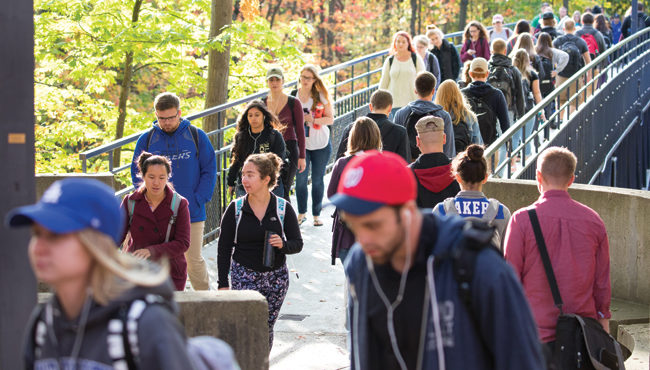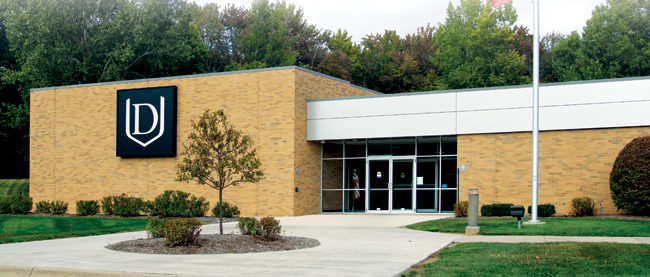

The headlines are everywhere: Outstanding U.S. student loans hit an unprecedented $1.5 trillion, the Federal Reserve reports. The middle class feels the cost of a college education is out of their collective reach. Surveys show Americans have lost their faith in higher education.
Colleges and universities nationwide are grappling with how to regain public trust, boost enrollment and maintain the standards the largely nonprofit sector previously enjoyed, when getting an advanced degree was considered a step toward the American dream and lifelong success.
Added to this challenge is the growing belief that today’s students, particularly Generation Z and its following cohorts, may not need college after all. Rising interest in vocational training and entrepreneurship is sparked by examples of people who did not graduate from a four-year university, including Microsoft’s Bill Gates, Mark Zuckerberg of Facebook and auto magnate Elon Musk.
That reality has some students and parents questioning whether college is a must.
Some companies back off on degree requirement
Moreover, well-known companies such as Google, Costco Wholesale and Penguin Random House have said they will not require all job applicants to have a degree. To date, as many as 14 percent of employees on some Google teams said they have never attended college.
Other firms, including KPMG and PricewaterhouseCoopers, are looking beyond degrees, because data shows they’re not predictive of career success or ability to perform in a job, according to Danny Iny, author of “Leveraged Learning: How the Disruption of Education Helps Lifelong Learners and Experts with Something to Teach,” published in October.
“These progressive companies aren’t the norm yet,” said Iny. “However, they are clear indicators of where the market is moving in a few years and a snapshot of how the landscape will look when today’s students start graduating. All in all, the cost/benefit ratio of a college education no longer makes sense for most students and parents need to stop pushing their kids into a system that isn’t working for them.”
As a result, many colleges and universities are looking at their return on investment—ROI—to see whether they can convince an increasingly skeptical nation that higher education is worth the time, cost and effort. By thinking more like a business— investing in marketing, trying more public-private partnerships, developing relationships with governments and companies to develop the future workforce —colleges and universities say they are responding directly to the needs of their communities, their students and, in turn, society as a whole, ensuring long-term success for their graduates and the rest of the nation.
This current crisis comes after colleges and universities enjoyed more than five decades of expansion after World War II. Enrollment grew rapidly as technology burst onto the scene, changing the kind of jobs that required additional education beyond high school. Higher education largely received accolades for diversifying their student bodies, making college an option for many ethnic and racial groups. They also boosted degree options to a rainbow of possibilities from cybersecurity to digital media to biometrics.
College and universities can only hope to grow, in terms of serving their purpose as educators, if they themselves are always evolving, said experts Larry Ladd and Matt Unterman, both Grant Thornton executives who helped write the consulting firm’s annual “State of Higher Education” report.
Ladd is the director and national industry specialist for the firm’s Not-for-Profit and Higher Education Practice, while Unterman is the firm’s principal of Advisory Services in the same area.
Universities as industry?
Higher education institutions may not like to think of themselves as businesses, Ladd said, but they must follow many of the same principles as the corporate world to be successful. This includes studying consumer behavior, watching trends, upgrading their facilities on a regular basis and giving people a reason to believe their products and services are an investment, rather than a waste of time or money.

“Colleges and universities are finding they have to focus on what other industries have looked at for some time, and that is finding out what the market and the communities they serve need,” Ladd said. “For many institutions, that means expanding beyond what is called the traditional student base and serving what was known as alternative populations, such as adults who are going back to school to earn a degree as they pursue a career. … Economically, it is quite advantageous for these institutions to go after more and different student populations, and leverage their fixed assets, such as their facilities.”
Ladd and Unterman suggest higher education organizations look at a variety of ways to adapt to today’s students and marketplace. These include horizontal growth—expanding their markets into new geographic areas; adding new programs; and expanding existing offerings, such as new schools or departments; as well as web-based education, such as Purdue University’s acquisition of online provider Kaplan University.
“Some are getting away from only offering conventional degrees, such as associate, bachelor or master’s,” Ladd said. “They’re finding opportunities to better serve and be sustainable financially through micro credentials, such as certificates or portions of a degree—so a student may get course credit toward a degree, but the classes are free- standing as a certificate or a skill set.
“There’s also the growth of what are sometimes called hybrid courses,” Ladd continues. “Think of these as a mix of land-based and online courses. You may share information online and in-person classes are then dedicated to discussion only. This is a more efficient use of everyone’s time. The student can get the information at their convenience and the faculty can focus on the application of the information and what it might mean.”
Aligning with businesses to close the much-discussed “talent gap” and develop degree programs that quickly fill the needs of rapidly growing industries, such as information technology, has been the recipe for success for other colleges and universities. For example, Grand Valley State University in Allendale, Mich., is closely working with companies who need employees who can write well, understand the intricacies of their chosen field of study and are realistic about the workplace.
“We work closely with area employers to assess the needs of employees and provide students with knowledge and skills they need for a career, not only the short-term workforce demands,” said Maria C. Cimitile, provost and executive vice president for Academic and Student Affairs.

“Also, we employ data-driven decision making and knowledge of national trends to be sure we provide relevant educational opportunities for our students, with a core of our liberal education foundation,” Cimitile said. “We believe at GVSU that a quality education is most important to our mission as an institution. Regardless of delivery methods, we ensure this quality for all our students.”
Another example of higher ed working with business and the community is Davenport University, which describes itself as “a career-oriented university” serving about 7,500 students at campuses across Michigan and online. The university’s areas of focus are business, technology, health professions and urban education.
A continual revinvention
The 152-year-old institution is the second largest private, nonprofit college or university in Michigan. Yet its president, Dr. Richard J. Pappas, describes Davenport as “an up and comer” whose agility and nimbleness has given it an advantage in a highly competitive higher education marketplace.
“We understand that higher education is (generally known as) slow and methodical. One of the things we pride ourselves on is practicality,” Pappas said. “We have the ability to move quickly. When someone has a need for job, we can’t wait two years to get a program together. We do it quickly, but we do it thoroughly.”
That is why Davenport University created a position called Director of Market Intelligence, where its only mission is to find where the new jobs are coming from, Pappas said. At the request of business leaders, Davenport University added 20 new graduate degrees in the past few years, all tied to the market.
“We’re willing to create new programs that are tied to the market right now; the challenge is exciting to us,” Pappas said. “We know the market and we know how to train and prepare students for high-paying careers.”
Davenport University also is willing to try new delivery methods, helping its technologically savvy students learn in a way that is both familiar and proven, said Lisa Howze, who serves as the school’s vice president for Detroit Campuses and Strategic Partnerships. She is responsible for leading the launch and growth of the Detroit campus, while also overseeing operations of DU’s Warren Campus.
Two years ago, Davenport introduced real time virtual learning, an online classroom designed to give students a convenient option when they might not be able to find the course on a local campus. Students connect through web conferencing equipment including cameras and headsets with microphones to provide a rich, interactive “virtual” classroom in real time.
“We say we’re agile because we can be responsive to the marketplace,” Howze said. Things such as real time virtual learning “make it easy for students to consider going back to school, because time is often a concern. We want to make sure we meet exactly where they are, by offering these different options.”

Traditional schools reach out to different populations
In Ann Arbor, the University of Michigan is like a lot of elite colleges enjoying long-term success because of the school’s century-old reputation and alumni who support its programs, as well as its athletic programs.
Its well-connected president, Dr. Mark S. Schlissel is the 14th president to hold the role and the first physician-scientist to lead the institution. Schlissel has been a visible part of the university within the media, business organizations and larger community.
To that end, the University of Michigan has received a record-setting number of college applications each year for the past 12 years, said spokesman Rick Fitzgerald.
“Our students and families are very conscious of the skills, knowledge and experiences needed to launch a successful career, and they arrive on our campus with particular goals in mind,” Fitzgerald said. “We are fortunate to be situated well to meet the academic and professional preparation expectations for a wide variety of careers paths.”
As a public institution, Fitzgerald said, the University of Michigan’s “dedication to academic excellence for the public good is inseparable from our commitment to diversity, equity and inclusion. For that reason, we have a number of innovative programs and initiatives designed to encourage interest and access from populations of students that have been historically underrepresented.”
These initiatives include the Go Blue Guarantee, a financial aid program that began in January and offers free tuition to most in-state undergraduate students from families with an annual income of up to $65,000. This straightforward promise helps to eliminate some of the confusion and uncertainty around the university’s financial aid resources.
Another program, Wolverine Pathways, is a supplemental educational program for students who live within the Detroit, Ypsilanti and Southfield school districts and who are entering seventh and 10th grades. The program is offered at no cost to students and families. Each student who successfully completes the Wolverine Pathways program applies to U-M and if admitted, is awarded a full tuition scholarship for four years.
Degrees still needed for some fields
Although enrollment, especially at community colleges, tends to dip when the economy is booming, having a degree of some kind remains essential for many career paths, notes Lexi Shankster, director of student success and mobility for the Institute for Higher Education Policy.
“Successfully serving returning students—in any economy—means providing the supports they need to persist and earn their degrees,” Shankster said. “According to census data, over 35 million adults in the United States, aged 25 years or older, earned some college credit, but stopped out before completing their degrees. In Michigan, nearly a quarter of adults have earned college credit, but no degree; roughly one-tenth of those adults have earned at least two years of credit with no degree to show for their hard effort.
“Labor economists’ projections show that employers will require a postsecondary degree for at least two-thirds of all jobs by 2020, but only 40 percent of Michiganders hold an associate degree or higher,” Shankster added. “These data underscore the urgent need for campuses, states, and policymakers to improve their ability to engage stopped-out learners and support these students along the path to successful degree completion.”





